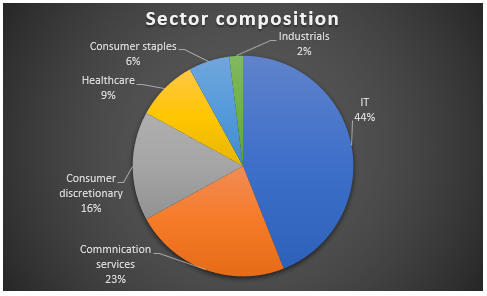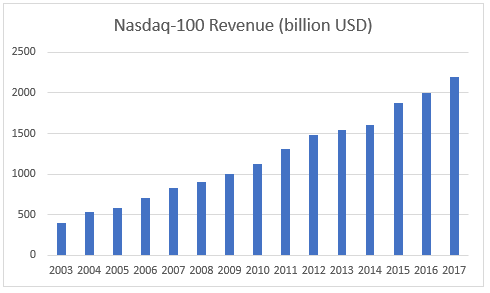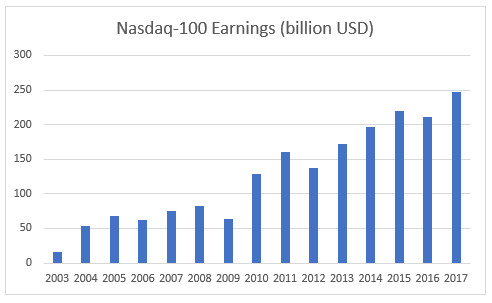Who If there is an equity market that is less correlated to the Indian market and provides a diverse set of companies to invest in, it is the US market. Hence, for portfolio diversification, we have traditionally preferred US to any other global market. If you decide to use the US route to diversify your portfolio, then it is best done through an index that accounts for more than quarter of the market cap of the New York Stock Exchange. We are talking of the Nasdaq 100. The NFO of Motilal Oswal Nasdaq 100 Fund of Fund (FoF) offers a simple route to gain exposure to the Nasdaq 100 without the hassle of a broking or demat account. The offer Motilal Oswal Nasdaq 100 (FoF) is a passive fund investing in units of Motilal Oswal Nasdaq 100 ETF (underlying scheme). Motilal Oswal Nasdaq 100 ETF trades on the Indian stock exchanges and replicates the Nasdaq 100. The local ETF has a track record of over 7 years but has traditionally suffered from poor liquidity. As a result, there may be days when you are unable to buy/sell the ETF. The ETF price also deviates from its NAV. The FoF route can help overcome the limitation of liquidity from an investor’s perspective. Your investments will only be done in local currency (rupees). The fund will be open ended and available for regular subscription and SIPs post the NFO period. About Nasdaq 100 For those not familiar with the US stock market, the most powerful and profitable companies on the globe are nested in the Nasdaq 100 index. The Nasdaq 100 Index is an equity index of top 100 non-financial securities listed on the NASDAQ stock exchange in the United States. The index has close to 45% exposure to technology stocks including global leaders such as Apple, Microsoft, Amazon, Google and Facebook. The index was launched in 1985 but gained traction in the past 15 years. This period has also seen the index constituents showcase tremendous growth in fundamental metrics. The index components posted a revenue growth of 14% and earnings growth of 24% compounded annually (from 2003 up to financial year December 2017. Source: Nasdaq). The index has delivered superior returns to the S&P 500 and the Dow Jones Industrial Average in the past 5 years. Although the Nasdaq 100 is tech heavy because of new-economy technology companies growing at tremendous pace in the internet age, the index also has other heavyweight names such as auto company Tesla, pharma company Mylan, food player Kraft-Heinz, toy maker Hasbro and trading giant Costco. There are a variety of ETFs that track this index in the US and across the globe. About Motilal Oswal Nasdaq 100 ETF The Nasdaq 100 ETF from Motilal Oswal was launched in March 2011 and has an AUM of less than Rs 100 crore. It is the only domestic ETF tracking the Nasdaq 100 index. The ETF delivered 18.9% annually in the past 5 years. This is superior to one of the best large-cap indices in India – the Nifty 100’s return of 12% in the same period. The Nasdaq 100 index itself delivered 13.8% over this period. The higher returns of the local ETF can be attributed primarily to rupee depreciation. In other words, local funds investing internationally benefit from a depreciating rupee. Still, lack of liquidity has seen the ETF deviate from its NAV in price and seen volatility in price daily. In recent days though, the price of the ETF has been converging with the NAV, suggesting that the AMC has been actively creating market makers and improving liquidity for the ETF. Motilal Oswal Nasdaq 100 ETF has also delivered better than most other international funds in India in the past 5 years; barring a few commodity funds that have flashes of high returns and then slip. For example, over a 5-year period, this ETF delivered 17.2% annually and the next best international fund (DSP US Flexible Equity) delivered 11.5%. Also, given that the US has a track record of well-managed indices like the Nasdaq 100 traditionally beating actively managed funds there, a US index, when available for Indian investors, would be a better way to invest in that market. Suitability Motilal Oswal Nasdaq 100 FoF, like any other equity product, is only meant for long-term investors. Added to the risk of fundamental factors in a foreign county, currency risk also exists in the fund. However, as the rupee has traditionally depreciated against the dollar, local investments into US have delivered higher than the dollar returns of their investments. The index is an aggressive high growth portfolio of stocks. It has also seen high volatility in the past. The NFO is suitable for all those looking to hold unique companies that are not present in the Indian stock markets. While the fund can be used as a general portfolio diversifier, it can specifically be used by those planning for expenditure (like foreign education) in the US. This will help counter the impact of a depreciating rupee. If you are serious about using the fund as a diversification tool meaningfully, then an exposure of at least 15-20% of your total equity would have to be allocated. Anything less may not lend market diversity nor meaningfully help counter any Indian market volatility. Giving the recent correction and volatility in the index, any lumpsum investments are best followed up through SIPs. Note that the FoF and the ETF receive only ‘debt fund’ status for tax purposes since they invest abroad. Hence, you will have to hold the fund for at least three years to benefit from capital gains indexation and a post indexation tax rate of 20%. The SID states that the expense ratio of the FOF can be up to 2.5%. However, based on the draft regulations of SEBI for a new expense ratio structure, the fund house has stated that the expense ratio of the FOF will have to up to 1%. Mutual fund investments are subject to market risks. Please read the scheme information and other related documents carefully before investing. Past performance is not indicative of future returns. Please consider your specific investment requirements before choosing a fund, or designing a portfolio that suits your needs.



1 year 3 years 5 years
MO Nasdaq 100 ETF 25.60% 18.00% 18.90%
Nifty 100 2.00% 10.80% 12.10%
Returns as of November 13, 2018. NAV returns of the ETF
Other articles you may like
What
[fbcomments]








Can someone advice on this? This appears to solve liquidity issues in MOST Nasdaq 100 ETF. Is it right to say that fund house will purchase this when investor is trying to sell? whereas in ETF, you need another investor?
Hi Rohit,
In an FOF (or any mutual fund), you’re buying and selling directly from the fund. So if you hold Motilal Nasdaq FOF and you redeem from it, the fund will return the proceeds to you. There’s no trading that will happen on the exchange. If you buy Motilal Nasdaq ETF, you will be buying and selling on the exchange like you would with any stock. So you’d need a matching order for your buy/sell order.
The Motilal FOF will improve liquidity of the ETF itself, as it can have higher volumes and more trading activity. It does not mean that the fund will purchase units every time you want to sell. AMCs employ market makers to ensure that there is liquidity in the ETF so that buying/selling happens smoothly and does not distort prices. Motilal Nasdaq FOF is not a market maker for the ETF. Its just another investor. Hope this clarifies your doubt.
Thanks,
Bhavana
Can someone advice on this? This appears to solve liquidity issues in MOST Nasdaq 100 ETF. Is it right to say that fund house will purchase this when investor is trying to sell? whereas in ETF, you need another investor?
Hi Rohit,
In an FOF (or any mutual fund), you’re buying and selling directly from the fund. So if you hold Motilal Nasdaq FOF and you redeem from it, the fund will return the proceeds to you. There’s no trading that will happen on the exchange. If you buy Motilal Nasdaq ETF, you will be buying and selling on the exchange like you would with any stock. So you’d need a matching order for your buy/sell order.
The Motilal FOF will improve liquidity of the ETF itself, as it can have higher volumes and more trading activity. It does not mean that the fund will purchase units every time you want to sell. AMCs employ market makers to ensure that there is liquidity in the ETF so that buying/selling happens smoothly and does not distort prices. Motilal Nasdaq FOF is not a market maker for the ETF. Its just another investor. Hope this clarifies your doubt.
Thanks,
Bhavana
How to buy Motilal Nasdaq FoF ?
Please share direct investment option and link
Hello,
If you’re a FundsIndia investor, the fund will be available under the Invest option in Mutual Funds or through New Investment on your portfolio dashboard. Else, please check with the investment platform you are using.
Thanks,
Bhavana
How to buy Motilal Nasdaq FoF ?
Please share direct investment option and link
Hello,
If you’re a FundsIndia investor, the fund will be available under the Invest option in Mutual Funds or through New Investment on your portfolio dashboard. Else, please check with the investment platform you are using.
Thanks,
Bhavana
hi, I have a doubt, during redemption how FX from USD to INR converted?
Hello,
Do you mean at the time you redeem from the fund? There’s no conversion that happens at any point. You invest in rupees in the fund and redeem in rupees. The fund’s holding is in rupees. When you buy or sell ETF units, you’re doing so in rupees. The Motilal FOF invests in units of the ETF. The ETF’s underlying portfolio will invest in the Nasdaq 100. Your buying and selling ETF units does not involve nor affect the ETF’s underlying portfolio. Only money infused directly into the ETF will change that. The ETF’s NAV and market price (you buy and sell at market prices) will reflect the rupee appreciation or depreciation. Hope its clear now.
Thanks,
Bhavana
hi, I have a doubt, during redemption how FX from USD to INR converted?
Hello,
Do you mean at the time you redeem from the fund? There’s no conversion that happens at any point. You invest in rupees in the fund and redeem in rupees. The fund’s holding is in rupees. When you buy or sell ETF units, you’re doing so in rupees. The Motilal FOF invests in units of the ETF. The ETF’s underlying portfolio will invest in the Nasdaq 100. Your buying and selling ETF units does not involve nor affect the ETF’s underlying portfolio. Only money infused directly into the ETF will change that. The ETF’s NAV and market price (you buy and sell at market prices) will reflect the rupee appreciation or depreciation. Hope its clear now.
Thanks,
Bhavana
Two related questions regarding this fund:
1. The NAV of the FOF is based on the ETF market price or the value of the constituent NASDAQ 100 index? I have seen the NASDAQ100 index drop while the ETF market price still appreciates on a given day.
2. What is the NAV cutoff time? Is it the same 3.00 PM IST as regular equity funds in India or based on US market timings? Suppose I buy units in the FOF today by 3pm and then tomorrow (well same day few hours later in the US) the NASDAQ100 index crashes by 10%, will I get the pre-crash or post-crash NAV?
Thank you!